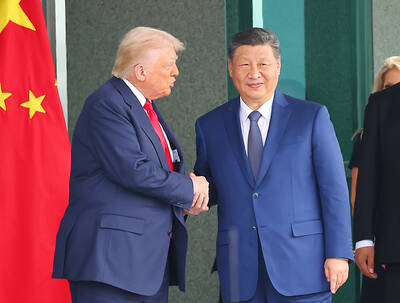Top trade officials from Mongolia and Taiwan held a forum yesterday in an attempt to strengthen economic ties between the two countries and attract Taiwanese investors the massive and unexploited Mongolian market.
"Many Taiwanese businesspeople are not familiar with Mongolia, but I assured them that they will find the nation a market full of potential if they would only visit it," said Huang Hua (
Taiwan currently has no diplomatic ties with Mongolia. The two countries set up representative offices in each other's capitals last September.
Mongolia, which seperates China and Russia with its vast 1.564 million km2 territory and a sparse 2.5 million population, depends on its economic lifelines of mining and the oil industry, which account for 65.5 percent of the country's exports. Wool is another important Mongolian export, as the nation is the second-largest supplier of cashmere in the world.
Mongolia began its transformation from a planned economy to a market economy in 1990, and the Mongolian government started reforming its economy by privatizing a large number of state-run companies and ushering in foreign investments in 1996.
According to Mongolia's Foreign Investment and Trade Agency, approximately 2,000 foreign companies in Mongolia made total investments of US$489 million, from 1990 to the end of 2001.
Last year, Taiwanese exports to Mongolia totaled US$4.94 million, and imports of Mongolian goods in Taiwan were US$92,341. There are 10 Taiwanese companies operating in Mongolia with investments of US$9 million. Half of the Taiwanese companies with a presence in Mongolia are investing in the textile industry.
Besides mining and textiles, tourism and consumer-goods manufacturing are rising stars in Mongolia.
"The most valuable resource that Mongolia has is its primitive environment, which could attract a huge number of nature lovers if adequate infrastructure is built," Huang said.
As for consumer-goods, Huang said due to unfavorable weather conditions and lack of a domestic manufacturing industry, Mongolia is highly dependent on imports of food and consumer goods from countries such as Russia, China and South Korea.
One businessman agreed with Huang, and said he had plans to tap into the food and manufacturing sectors in Mongolia.
"I think the foodstuff industry is a worthwhile investment due to the continual shortage of food -- especially during winter, which lasts seven months in the country," said Michael Yu (
Yu also said Mongolia could become a manufacturing center in central Asia by using cheap res-ources from China to produce high added-value products.
However, transportation is the main obstacle that may dampen the interest of Taiwanese investors, as Mongolia is remote from Taiwan and there are no direct flights between the two countries, said Liu Kun-chun (
"I admit that Mongolia has many advantages that are worthy of investment, but I won't comment on the inconvenient and costly transportation," said one official from the Importers and Exporters Association of Taipei (

Nissan Motor Co has agreed to sell its global headquarters in Yokohama for ¥97 billion (US$630 million) to a group sponsored by Taiwanese autoparts maker Minth Group (敏實集團), as the struggling automaker seeks to shore up its financial position. The acquisition is led by a special purchase company managed by KJR Management Ltd, a Japanese real-estate unit of private equity giant KKR & Co, people familiar with the matter said. KJR said it would act as asset manager together with Mizuho Real Estate Management Co. Nissan is undergoing a broad cost-cutting campaign by eliminating jobs and shuttering plants as it grapples

TEMPORARY TRUCE: China has made concessions to ease rare earth trade controls, among others, while Washington holds fire on a 100% tariff on all Chinese goods China is effectively suspending implementation of additional export controls on rare earth metals and terminating investigations targeting US companies in the semiconductor supply chain, the White House announced. The White House on Saturday issued a fact sheet outlining some details of the trade pact agreed to earlier in the week by US President Donald Trump and Chinese President Xi Jinping (習近平) that aimed to ease tensions between the world’s two largest economies. Under the deal, China is to issue general licenses valid for exports of rare earths, gallium, germanium, antimony and graphite “for the benefit of US end users and their suppliers

Dutch chipmaker Nexperia BV’s China unit yesterday said that it had established sufficient inventories of finished goods and works-in-progress, and that its supply chain remained secure and stable after its parent halted wafer supplies. The Dutch company suspended supplies of wafers to its Chinese assembly plant a week ago, calling it “a direct consequence of the local management’s recent failure to comply with the agreed contractual payment terms,” Reuters reported on Friday last week. Its China unit called Nexperia’s suspension “unilateral” and “extremely irresponsible,” adding that the Dutch parent’s claim about contractual payment was “misleading and highly deceptive,” according to a statement

The Chinese government has issued guidance requiring new data center projects that have received any state funds to only use domestically made artificial intelligence (AI) chips, two sources familiar with the matter told Reuters. In recent weeks, Chinese regulatory authorities have ordered such data centers that are less than 30 percent complete to remove all installed foreign chips, or cancel plans to purchase them, while projects in a more advanced stage would be decided on a case-by-case basis, the sources said. The move could represent one of China’s most aggressive steps yet to eliminate foreign technology from its critical infrastructure amid a